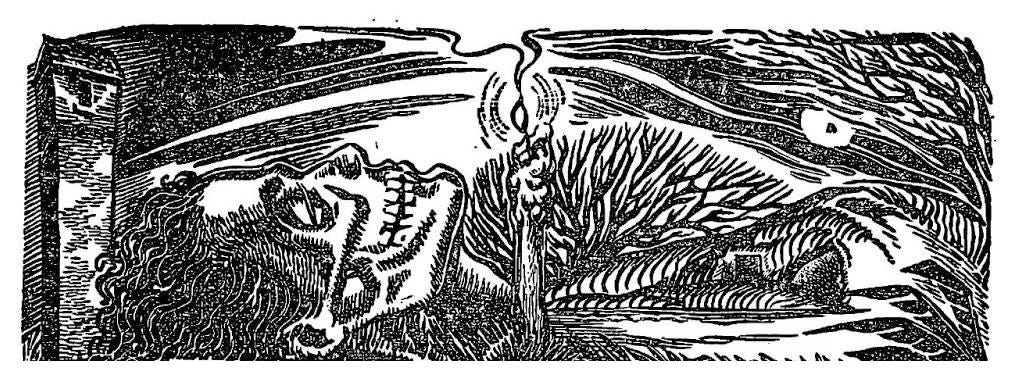“A ghastly inner shriek seemed to tear through somnolent consciousness. In despairing horror I wailed to myself, ‘I’m dying! I’m dying!’”
Thus began Pelley’s famous “Seven Minutes” experience wherein he was reunited with former acquaintances who had died. In the wake of this episode he developed the clairaudient ear that would serve him with his channeled writings over the next 30 years.
The idea of sleep overlapping death and allowing for the acquisition of knowledge beyond the grasp of waking mind is elemental to Pelley’s spiritual doctrine. If you are not willing to accredit such things, Soulcraft will remain foreign to you.
The original American Magazine article printed in the March, 1929 issue was titled “My Seven Minutes in Eternity.” Most accounts relating the event second-hand will refer to Pelley having spent only seven minutes beyond the veil. This faux pas reveals the work of a writer who never bothered to read the story.
Modern writers familiar with basic paranormal jargon often refer to Pelley’s episode as an early popular case of astral projection, out-of-body experience (OOBE) or near-death experience (NDE). Call it what you will, the time he spent in the company of dead friends that night amounted to several hours.
When he first arrived, falling naked from the sky into the arms of two men dressed as orderlies, one of the men observed his overwhelmed condition as he opened his eyes and glanced around.
“Take it easy, old boy. Don’t try to see everything in the first seven minutes,” his new companion told him. The editors at the American Magazine struck on that quote for the title, amused by the idea that earthly units of time were observed in the condition we think of as eternity. I think the addition of “My” to the title has baited hundreds of lazy writers over the decades since. I prefer “Seven Minutes” without the possessive, as it has appeared in reprint editions since.
“Seven Minutes” was an epiphany for Pelley. His future shifted dramatically. Something had come back with him. Perhaps something of himself had stayed behind.
To follow a string of comparisons to pop culture archetypes, Pelley has something in common with comic book figure Jonah Hex; the near-death experience from which he returns with the uncanny ability to communicate with the dead. It’s sensational, but Pelley wrote it and, he asks us to believe, lived it first.
https://en.wikipedia.org/wiki/Jonah_Hex
Pelley refers to second-sight as being characteristic of the Scots. In our family it was said that Nanny, my grandmother, was fey. The syllable is a weighty one. My aunt used it to describe the habit her mother had for knowing when someone had died before being told. At least, before being told by anyone still living.
On several occasions my aunt had gone to let her mother know of the death of a cousin or niece. My aunt was a nurse and I suppose our relatives looked to her as the one to bear bad news. She was usually first to receive the phone call. She was comfortable with death, at least when it came naturally, and had a confident yet caring bedside manner.
On one occasion Aunt Esther went to tell Nanny about the death of cousin Vivian. When she walked in the house Nanny started asking about my other aunts. “Have you heard from your sisters today?” Esther had spoken to both of them that morning. They were fine. She could tell Nanny was anxious.
“What’s the matter, Mom?”
“Your Uncle Walter was here,” Nanny said.
Walter was her brother who had died as a young man during the flu epidemic in January of 1919.
Aunt Esther knew what it meant. Uncle Walter always came to let his sister know when a family member was fated to die. He was the angel of death. The “gift” was troubling to grandma. My aunt prayed that she would never inherit it.
“I have some sad news, but it sounds like you already know. Cousin Vivian died.”
Vivian was one of Walter’s daughters.
“Oh, how selfish of me,” Nanny said. “He said he had come for one of the girls. I thought he meant one of my girls… so selfish.”
My grandmother’s story is very similar to the story of Bertie Lily Candler, Pelley’s favorite medium, before she developed her ability and took up the practice. Bertie Lily had lost a brother who would appear to her with messages from the other side.
To further consider this term fey, by some definitions it means “near death” while another context describes it not as “one foot in the grave” but rather “one foot beyond the grave.” I recognize it as a condition of being in contact with the dead; living with the dead.
Had Pelley come back from “eternity” fey? Again, this is how I connected to things I was learning about the Chief from a personal perspective. His experience and his way of relating it rang true to me, as it did to 30,000 readers of the American Magazine in 1929 who sent letters in reaction to his account.





